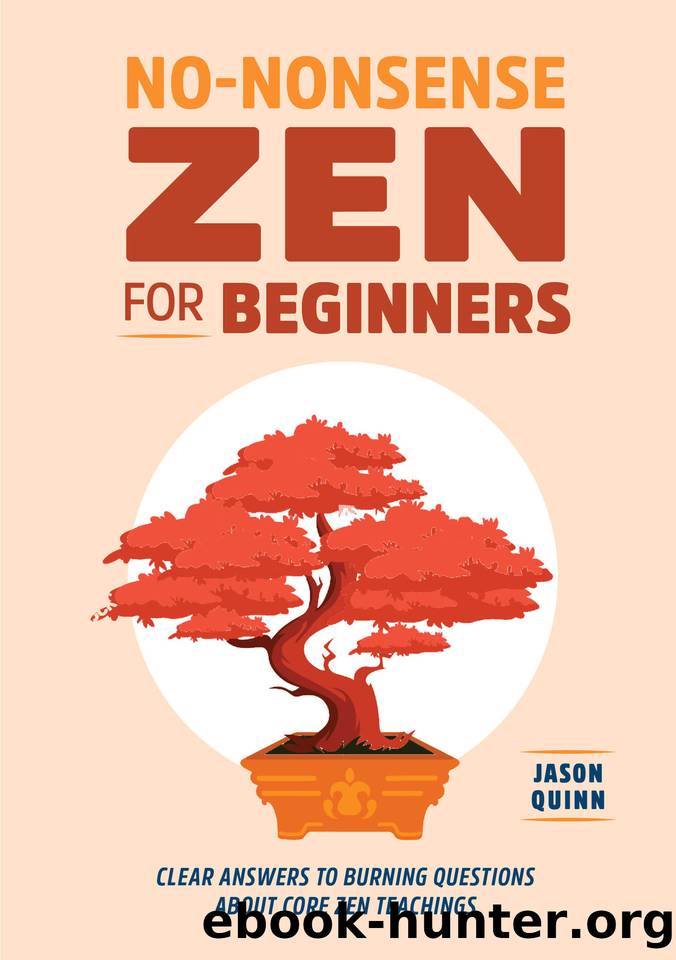No-Nonsense Zen for Beginners: Clear Answers to Burning Questions About Core Zen Teachings by Quinn Jason

Author:Quinn, Jason
Language: eng
Format: epub
Publisher: Rockridge Press
Published: 2021-08-16T16:00:00+00:00
Part Three
CORE TEACHINGS
What Youâll Learn: In this section, youâll learn about important teachings such as dharma, nirvana, life and death, impermanence, and how they relate to Zen in a simple and accessible way. We will also look at teachings such as ego, suffering, and enlightenment, and how to put these teachings into practice during our everyday lives.
What are the three most essential aspects of Zen practice?
There are three elements in Zen practice that give us a solid foundation for our practice and our lives: Great Doubt, Great Courage, and Great Faith.
Great Doubt should not be confused with self-doubt. Self-doubt is a feeling of uncertainty, or lack of confidence or belief, in something that arises from the self or ego. Great Doubt is looking at our lives and this world with curiosity. It is questioning everything to help return us to âdonât knowâ mind, our original enlightened nature before the concept of self. Great Doubt challenges our assumptions and beliefs so we can look at this moment with clarity. Many of us have spent an entire lifetime building up a false concept of ourselves and this world. Our happiness, security, comfort, and strength depend on this concept. It almost seems that if we discover the truth about ourselves, then everything that we have built up, all the happiness, security, comfort, and strength, will disappear. If it all disappears, then what? This raises Great Doubt. Who are we? What are we? What is this? Great Doubt can help break those walls of ourselves down so we can see our true selves.
Great Courage is having the courage to look inside and face the reality of our mind. It takes courage to look at our attachments, judgments, and all the things about ourselves that are difficult to see with openness and sincerity. It takes courage to use Great Doubt to see through our concept of ourselves and this world. It takes courage to stand up and respond to this world with love and compassion. If we donât use this courage, then we remain stuck in our old ways and habits. Practicing with other people can help us have the courage, because practicing by ourselves can be very difficult at times. We call this communal practice âsangha,â and it can encourage and support us when things are difficult.
Great Faith is not faith in something outside ourselves; it is the faith that we are already enlightened. It is having the faith that we are already Buddha. It is trusting the intuition that we already have. We lose this faith because of our attachment and our clinging to our thoughts and the material world. When we take the courage to use Great Doubt to question and challenge our ideas and beliefs, we start having faith in our true self. Great Doubt, Great Courage, and Great Faith are like a three-legged stool. They all depend on each other to give us strength and clarity in our lives. And a three-legged stool can always find balance.
What is dharma?
In Buddhism, âdharmaâ refers to the teachings of the Buddha.
Download
This site does not store any files on its server. We only index and link to content provided by other sites. Please contact the content providers to delete copyright contents if any and email us, we'll remove relevant links or contents immediately.
Four Thousand Weeks by Oliver Burkeman(1745)
What Happened to You? by Oprah Winfrey(1732)
Karma by Sadhguru(1565)
This Changes Everything by Unknown(1469)
You Are a Badass: How to Stop Doubting Your Greatness and Start Living an Awesome Life by Jen Sincero(1132)
Don't Sweat the Small Stuff...and It's All Small Stuff by Richard Carlson(1068)
Infinite Circle by Bernie Glassman(1015)
How to Do the Work by Dr. Nicole LePera(962)
Let's Talk About Hard Things by Anna Sale(948)
Real Strength: Build Your Resilience and Bounce Back From Anything by Psychologies Magazine(919)
Declutter Your Mind: A step by step guide to learn to control your thoughts, stop worrying, relieve anxiety and eliminate panic attacks and negative thinking by Mia Chandler(919)
The 4-Hour Workweek by Timothy Ferris(907)
Who Moved My Cheese? by Spencer Johnson(894)
The Path of Greatness--The Game of Life and How to Play It and Other Essential Works by Florence Scovel Shinn(892)
Be Your Best Self by Mike Bayer(861)
Breakup Bootcamp by Amy Chan(860)
Curative Magic by Rachel Patterson(845)
Advice for Working Moms (HBR Working Parents Series) by unknow(824)
The Self Compassion Workbook: Practical Exercises to Approach Your Thoughts, Emotions, and Actions with Kindness by Johnson LCSW Joy(818)
